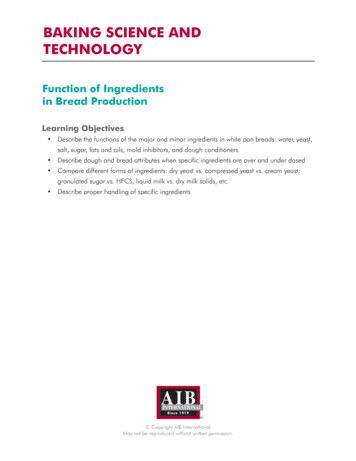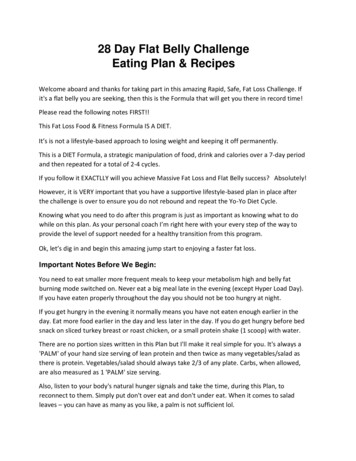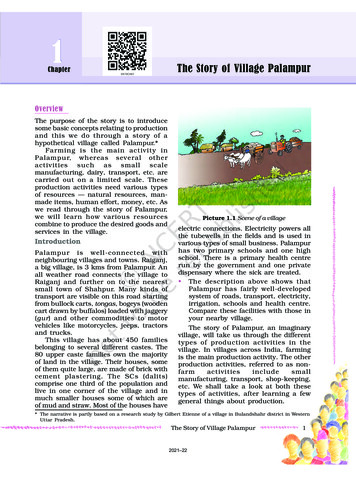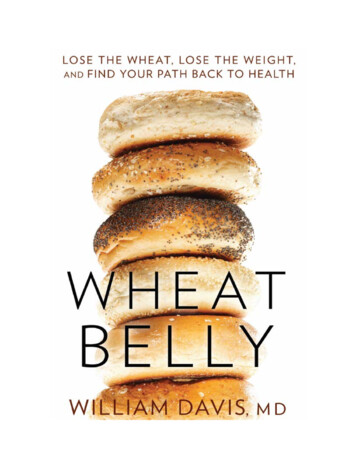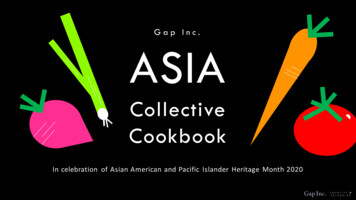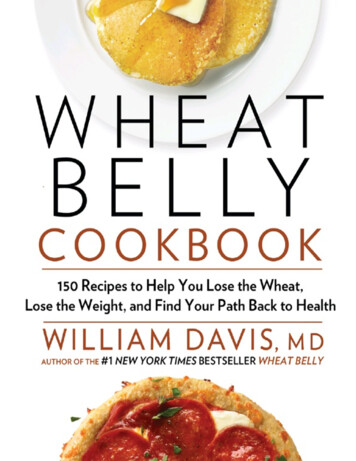
Transcription
WHEATBELLYCOOKBOOK150 Recipes to Help You Lose the Wheat, Losethe Weight, and Find Your Path Back to HealthWILLIAM DAVIS, MD
To everyone who has come to understand the liberation that emerges withwheatlessness.
CONTENTSCoverTitle PageDedicationIntroductionPART 1: HEALTH, WEIGHT, AND LIFE THE WHEAT BELLY WAYFrankengrainWhy Does My Stomach Hurt?Welcome to the Wonderful State of WheatlessnessAssembling Your Wheat Belly KitchenPART 2: WHEAT BELLY COOKBOOK RECIPESBreakfastsSandwiches and SaladsAppetizersSoups and StewsMain DishesSide DishesSauces and Salad DressingsThe Wheat Belly BakeryAppendix A: Wheat, Wheat EverywhereAppendix B: Wheat-Free out the Publisher
INTRODUCTIONThe truth will set you free, but first it will piss you off.GLORIA STEINEMWHEAT IS NOT the “healthy whole grain” it was pretending to be. Like a faithful spouseexposed as a philanderer and polygamist, wheat is not to be trusted. Held up as an iconof health, it is in reality a major contributor to the world’s worst epidemic of obesity andan astounding list of health problems, from simple annoyances like dandruff toincapacitating conditions like dementia.This is a cataclysmic revelation for most people: It’s unsettling, it’s upsetting, it’sdownright inconvenient. The condemnation of wheat is as paradigm shifting, earthshattering, and life changing as the emergence of the Internet, the packaging ofcollateralized debt obligations and the collapse of mortgage markets, the upheavals ofthe Arab Spring events that shook core beliefs, upended comforting habits, andchanged worldviews.Wheat is the Enron of the food world, the tobacco industry all over again—frauds, bothintentional and inadvertent, conducted on an international scale. Charming and engagingon the outside, sociopathic and destructive on the inside, it works its way into your life,wreaking havoc in every conceivable health-destroying way.These are, for those of you unfamiliar with the arguments set forth in Wheat Belly:Lose the Wheat, Lose the Weight, and Find Your Path Back to Health (Rodale, 2011),undoubtedly bold assertions that fly in the face of nutritional wisdom. The DietaryGuidelines for Americans issued by the USDA and the US Department of Health andHuman Services, as well as the American Heart Association, the American DiabetesAssociation, and the Academy of Nutrition and Dietetics all agree: Healthy whole grainsshould make up a substantial portion of your diet.This is colossally bad advice. “Eat more healthy whole grains” is among the biggesthealth blunders ever made in the history of nutritional advice. Modern health care,treating millions of people at the cost of hundreds of billions of dollars every year forhypertension, high cholesterol, obesity, arthritis, acid reflux, irritable bowel syndrome,fibromyalgia, migraine headaches, depression, diabetes, various forms of neurologicalimpairment, and on and on, is really treating wheat consumption. And the endlesslyrepeated advice to eat more “healthy whole grains” fuels this fire, much to theappreciative applause of the pharmaceutical industry. After all, the pharmaceuticalindustry funds a good part of the wheat lobby promoting and propagating this message.Oh, you didn’t know that? Yes, a long list of drug manufacturers have close financial tiesto the organizations that lobby Congress, help establish school lunch policy, and get cozywith the USDA to maintain the lofty nutritional role of “healthy whole grains.”
And, yes, the clinical studies documenting these arguments have already beenperformed, but rarely do they make the light of day in media supported by Big Food, whocount wheat products among the handful of commoditized ingredients, subsidized by theUS government, that serve as the basis for most processed foods.In health, as in software, we are living examples of the principle of garbage in, garbageout. Put this stuff, the creation of geneticists from the 1960s and 1970s, into your body,and you get all manner of unanticipated health effects.Since the release of Wheat Belly, I have become convinced that not only is this anincredibly big issue for health, the situation is worse than it first appeared. It has affectedfar more people than I originally anticipated and to such an extraordinary degree that it isdifficult to overestimate the severity of this problem. This is no fad that will flare and thenburn out, much as the misguided low-fat notion has. This is not a dietary precept like “getmore fiber.” It is an exposure of the genetic and biochemical changes introduced into thiscommon foodstuff, all in the name of increased yield-per-acre, but with no questionsasked about its suitability for human consumption.We are, in effect, experiencing the consequences of a grand agricultural experimentgone sour.Hey, Marlboro Man: Have a Bagel!Remember this? “According to a nationwide survey: More doctors smoke Camels than anyother cigarette”? In the mid- and latter 20th century, the national discussion went fromgushing about the pleasures and health benefits of smoking, to studies documenting thehealth damage caused by smoking, to executives denying any wrongdoing to Congress,to uncovering concealed documents demonstrating the industry’s knowledge of theadverse health effects of smoking decades earlier.We are reliving the tobacco experience with wheat in its place. I believe that smartfood scientists stumbled on the appetite-stimulating effect of the gliadin protein in wheat25 years ago. How else do we explain why wheat is in virtually all processed foods, fromtomato soup to licorice? In 1960, you would have found wheat in bread, rolls, and cakes—obvious places that make sense. Go up and down the food aisles in your localsupermarket in the 21st century, and you will find that nearly all canned, packaged, andfrozen foods contain wheat in some form. Is wheat that necessary for taste, or fortexture? I don’t think so. I think it’s put there for one reason: to stimulate your appetiteand increase sales.The transformation of the gliadin protein in newly created strains of wheat wasaccompanied by an increase in calorie consumption of 440 calories per day. By puttingwheat in everything, the food industry, especially Big Food, ensured that you come backfor more. Just as tobacco manufacturers increased nicotine content of cigarettes toensure addiction, so adding wheat to every processed food created addictive behavior inresponse to all things wheat. Eating 440 more calories per day, 365 days per year—notonly does that add up to a lot of calories and a lot more food consumed, it adds up to a
lot more weight. (Using a simple calories-in calculation, this yields 160,000 calories, or45.8 pounds gained in a year. This is an oversimplification, since calories-in, calories-outis a flawed concept, but it nonetheless illustrates how substantial this effect can be.) Theintroduction of the new form of gliadin was followed shortly thereafter by a nationwideincrease in weight. After people gained 30, 50, 60, or more pounds, an explosive surge indiabetes followed. We are now in the midst of the worst epidemic of diabetes everexperienced by humans, such that the curve showing the number of people with diabetesis in a vertical climb straight upward, a trajectory that is likely to engulf your children andgrandchildren.The gliadin protein of wheat ensures that wheat products, such as whole grain or whitebreads, bagels, and muffins, are addictive: They generate a need for more and more,and more. Gliadin is an opiate, you will discover, with its own form of euphoria and itsvery own opiate withdrawal syndrome when wheat consumption stops that can also beprovoked with opiate-blocking drugs.So the inadvertent transformation of wheat gliadin into a much more potent appetitestimulant, recognized quickly by observant food scientists, brought us here, to thisoverweight, diabetic situation that now plagues Americans and much of the rest of thedeveloped world while we are advised to eat more “healthy whole grains.” No doubt,many people profited handsomely—and continue to do so—from this message, but thepublic has paid the price, both with their pocketbooks and their health.There’s Power in Them TweetsSince the release of the first Wheat Belly, social media has served the role of a worldwidestage for these arguments to play out.Some things, when enacted in real life in real people, are so consistent and powerfulthat, despite their anecdotal nature, they serve to reinforce what we learn throughscientific observation. If I hit my head with a hammer and it hurts, and my head stopshurting when I stop hitting it, do I need a double-blind, randomized clinical trial to provethat hitting my head with a hammer causes head pain? The association is so consistentand obvious that you can safely accept the premise that the hammer is the cause.Likewise, eliminating wheat has been demonstrated, through the thousands of peoplewho have embraced these ideas, to produce life-changing transformations of health andweight that most thought were impossible, allowing them to throw away multiplemedications and leave behind years of pain, wheezing, diarrhea, cramps, swelling, fatigue—within days of saying goodbye to their bran muffins or breakfast cereal.In the Middle East, social media allowed the masses to organize, communicate, andoverthrow despotic dictators. In no other time in history could dissent disseminate sorapidly, revolt be organized within hours. Likewise, social media is now showing us, on anunprecedented scale and abbreviated timeline, that rejecting all things wheat is amongthe most powerful and liberating health strategies imaginable. We purge this MuammarGaddafi of diet using the facility and speed of Twitter, Facebook, and other electronicmedia, spreading the word of dietary revolution using the very same tools.
This is not a popular message at the USDA, or in the halls of Big Food and BigAgribusiness. It’s not uncommon, for instance, for agribusiness giant Monsanto to spendmore than 2 billion per quarter to lobby the federal government to influencepolicymakers—and that’s just one company. Dollar for dollar, we cannot even begin tocompete with such forces. Ah, but we can talk to each other and share our experiences,something that these dominating corporate forces are unlikely to do with us.Lose the Wheat, Lose the Weight and the Acid Reflux, and theEdema, and the Mental “Fog” Much like when you stop hitting your head with a hammer and the headache miraculouslygoes away, so eliminating all wheat from the diet is followed by the majority of peopleexperiencing abrupt and substantial weight loss along with relief from a long list of healthconditions.In other words, the proof of this concept is in your own hands, a simple rearrangementof food priorities in your own pantry. You don’t have to wait for a large-scale clinical trialto know whether this is relevant to your health situation. If you decide to wait fornational advice to embrace this concept, you are going to wait a very, very long time.How do official agencies undo the disastrous advice of the last 40 years without losingcredibility, without incurring legal liability for the unimaginable economic damages—andwithout losing the revenue stream that this corrupt message has generated? You don’thave to wait. You can start the process and know within days whether this thing calledwheat has been to blame for your health and weight.The total effect experienced in eliminating wheat is greater than the sum of its parts:It’s a 2 2 11 phenomenon. That’s no typo. Getting rid of wheat is that big. Despiteour knowing about many of the undesirable changes introduced by geneticists intomodern wheat, the health changes—health transformations—experienced by most peoplewho say goodbye to wheat are often far greater than we’d predict. It makes for some ofthe most compelling success stories in weight and health you could imagine.Gluten-Free and Other BlundersA growing number of people are declaring themselves gluten free, thereby buying andconsuming gluten-free foods.Big mistake. Yes, it’s a very good thing to avoid the gluten from wheat. But this cantake you down the path of gluten-free processed foods. Oddly, the majority ofmanufacturers of gluten-free foods have chosen to base their products—with rareexceptions—on rice starch, cornstarch, potato starch, and tapioca starch. While they mayprovide a reasonable facsimile of gluten-containing wheat flour–based products in tasteand texture, they are among the few foods that raise blood sugar even higher than thehigh levels generated by wheat products. In other words, gluten-free multigrain bread orgluten-free pasta, from the perspective of high levels of blood sugar and itsconsequences, are poor choices as replacements for wheat.
So we should be wheat free and gluten free, but also free of gluten-free foods madewith junk carbohydrates.A bit confusing, yes. This was part of my motivation for adding the Wheat BellyCookbook to the discussion, to help you re-create delicious foods without wheat andwithout the rice starch, cornstarch, potato starch, and tapioca starch of commercialgluten-free foods. The recipes presented herein are tasty, don’t screw with blood sugar,don’t trigger appetite, and are truly healthy—a novel concept!Lettuce and Cardboard?For many people, the prospect of giving up wheat is daunting, even downright terrifying,especially since wheat comes with its very own withdrawal syndrome. Not only might yoube deprived of something that yields an addictive relationship, but what foods willremain? Will you starve? Will you have to live on lettuce, cardboard, and tastelessreplacement foods?Not at all. As many wheat-free people will attest, foods minus wheat are actually moreenjoyable. A fundamental change occurs when you remove this addictive food: You enjoyfood for its own sake, not because there is an appetite stimulant present making you eatanything you can get your hands on. Taste is heightened: You are better able to discernthe nuances of foods, but also more sensitive to sweetness, with formerly tasty treatsnow sickeningly sweet. You are less hungry to the tune of 440 fewer calories per day;what you eat, you enjoy more since you are having less.Foods can be wonderfully varied without wheat. In addition to beef burgundy and pizza,you can have muffins, cookies, pies, scones, and other former wheat-containing foods,made using truly healthy ingredients. These are among the 150 recipes in the WheatBelly Cookbook.What this is not is a gluten-free cookbook. No food manufacturer or author of a glutenfree cookbook I know of yet understands the principles of healthy wheat-free, gluten-freeeating sufficiently to craft truly healthy gluten-free food. If you want to get fat anddiabetic, develop cataracts and arthritis, and grow a belly full of inflammatory visceral fat,eat gluten-free substitutes sold in stores or follow the recipes in the newest gluten-freecookbook. So the recipes I’ve developed here are indeed free of wheat and gluten,limited in carbohydrate exposure—and truly healthy.Quit Your Bellyaching!“Don’t you miss it?” and “Aren’t you tempted to eat a doughnut?” are among the commonquestions from those contemplating a life sans wheat.If, by the end of these opening chapters, you aren’t eyeing your beloved multigrainbread or onion ciabatta with suspicion or outright horror, then I haven’t done my job. Isee my role as exposing these arguments to the light of day for all to see, not just thetarted-up, hunky-dory version presented to us by those who profit from influencing themessage. My hope is that, by the time you have finished reading the first few chapters,
you will understand that not only is this creation of genetics research awful for weightand health, it is downright deadly. Removing it is liberating. It’s the rainbow after thestorm, remission after cancer treatment, viewing bright colors after a lifetime ofblindness.Be sure to read the success stories that I’ve peppered throughout the recipe sectiondetailing many of the compelling tales of health and weight turnarounds that have comemy way ever since this message has gained an international audience. Read real storiesof dramatic weight loss, relief from crippling health conditions, transformations ofchildren’s behaviors—all from people denying themselves the effects of this creation ofmodern genetics research called wheat.
PART 1HEALTH, WEIGHT, AND LIFE THE WHEATBELLY WAYLet’s begin by surveying the wheat landscape. We find that it is no longer afield of beautiful “amber waves of grain,” but a field of something different. Itis also a battleground of obesity, diabetes, and legions of people who havesuccumbed to its effects.We begin the discussion on modern wheat in three parts.FRANKENGRAINAgricultural scientists have stitched the genetics of this thing together,concocted from extensive, sometimes bizarre experiments to increase yieldper-acre of wheat.How has it changed? Just as the Frankenstein monster, the creature createdwith body parts woven together in a laboratory, terrorized the countryside, sothis Frankengrain has worked its way onto your kitchen table, doing its dirtydeeds on your health. This gets a bit complicated, but you will discover that thedeeper we dig, the worse it gets. You will gain an understanding of just howfar off course this thing has been taken from its natural state.WHY DOES MY STOMACH HURT? AND WHY DO MY JOINTS ACHE,AND MY BOWELS RUMBLE, AND MY FEET SWELL, AND MY It’s not wheat. At least it’s not the wheat of 1950, and certainly not the wheatof centuries past. It’s no more wheat than rapper Snoop Dogg is WolfgangAmadeus Mozart.This creation of the genetics laboratory is different, altered in fundamentalways that increase appetite, ignite inflammation, grow visceral fat, skyrocketblood sugar, destroy intestinal and joint health, and wreak a long list of otherhavoc on health and metabolism.WELCOME TO THE WONDERFUL STATE OF WHEATLESSNESSIf consuming modern wheat makes us fat and destroys our health, thenremoving it should undo the entire mess and it does!Remove sugar and you lose a few pounds and blood sugar trends down.
Remove wheat and joints feel better, acid reflux goes away, rashes disappear,mental “fog” disappears, energy increases, sleep is deeper, food obsessions aregone, asthma improves or disappears, leg swelling shrinks—oh, and you lose afew pounds and blood sugar trends down. Nothing—nothing—matches thehealth impact of losing the wheat, the “healthy whole grains,” in your diet.We go one step further: If you eliminate wheat, health and weight are notnecessarily ideal if you continue to consume soft drinks, gumdrops, and theirdietary equivalents. So we also discuss why limiting nonwheat carbohydratesis important, too, especially if you are trying to lose weight.We then tackle the day-to-day particulars in ASSEMBLING YOUR WHEAT BELLY KITCHENHere we discuss everything from what to banish from your kitchen to whatwheat-free flours to choose to re-create cupcakes, cookies, and cheesecake.Life is good after saying goodbye to wheat! You are healthier, more energetic,and more slender—while indulging in delicious brownies and pizza.Okay, let’s get started and kiss your sorry wheat-consuming butt goodbye!
FRANKENGRAIN it is true that I am a wretch. I have murdered the lovely and the helpless; I havestrangled the innocent as they slept and grasped to death his throat who never injuredme or any other living thing. I have devoted my creator, the select specimen of all that isworthy of love and admiration among men, to misery MARY SHELLEYFrankenstein; or, The Modern PrometheusWHEAT ENCAPSULATES a fundamental dilemma of our technological age: How muchshould we permit modern agriculture to modify our food, change its genetics, alter itsbiochemistry—but not tell us what they did, how they did it, why they did it, and thatthere are potentially uncertain effects on us unwitting humans who consume it with ourbreakfast burrito?If your hairdresser one day decided to give you a new hairdo and dye your curls red,surely she would discuss this with you first. If your spouse decided that life would bebetter in Anchorage, Alaska, wouldn’t it first come with a bit of discussion?The production of our food does not seem to adhere to such common courtesies. Foodcrops and livestock are changed, you buy them, you eat them—no questions asked. Thechanges introduced are not just that of a new color, or an adaptation to grow under someunique condition. The food is, in many cases, fundamentally changed.More than any other common foodstuff, wheat stands apart as the most changed.Selling bread, pretzels, or ciabattas to you under the guise of wheat is a deception thatyou would not tolerate in other areas of your life, certainly not from your hairdresser orspouse.Modern wheat represents the technological capabilities of agricultural geneticists thatpredate the age of genetic engineering and genetic modification, the use of gene-splicingtechnology to insert or delete a gene. Wheat represents the brainchild of geneticsmanipulations that were employed before such technologies were developed. Wheatrepresents the product of genetic methods that were crude, often stumbling, lesscontrollable, less predictable—far worse than genetic modification. Yes, believe it or not,modern genetic modification using gene-splicing technology to insert or delete singlegenes, as frightening as it may be in its implications to mess with nature’s design,represents a substantial improvement over what geneticists were doing previously.Using breeding methods that predate genetic modification, geneticists were unable toprecisely control which genes were changed, which genes were turned on or turned off,and whether entirely new and unique genetic traits were created by accident. Theysimply looked for the characteristics relevant to their own interests, such as shorterheight or greater yield, but had no real interest in nor insight into what the total package
did to humans. Why would they, since none of us ever asked?And yet the products of these stumbling early efforts at creating “improved” geneticvariations of your food are already on your store shelves. And you’ve been consumingthem for something like 35 years.Healthy Whole What?“Healthy whole grains.” It is the mantra you hear and see repeated dozens of times eachday in TV commercials, on cereal boxes and bread wrappers, and by well-meaning peopleoffering nutritional advice. The message is delivered by happy moms, sports figures,superheroes and well-dressed leprechauns, well-intended nutritionists and concernedphysicians. Whole grains are good for everybody, they say: every man, woman, and child,from infancy on up to our retirement years. Whole grains reduce weight gain, coloncancer, diabetes, and heart disease. Whole grains make you regular. Whole grains shouldrepresent the biggest part of your diet every day.Just what are “healthy whole grains”? By “grains,” we nearly always mean wheat. Afterall, how many times a day do you sit down to a sandwich with bread made of sorghumflour, breakfast cereal made of quinoa, or pancakes made with millet and buckwheat? Ifyou are like most people, it is rare to never. It’s wheat that constitutes nearly all of whatmost people consider “whole grains” and thereby dominates consumption. Whole wheat,along with white flour products in their many and varied forms, dominates the diets ofmost people, adding up to 20 percent of all human calories. It’s wheat that’s in your pizzacrust, bagels, pretzels, bread, pasta, muffins, breakfast cereals, doughnuts, hamburgerand hot dog rolls, dinner rolls, bread crumbs and breading, pitas, wraps, subs, andsandwiches. And those are just the obvious sources.Grains occupy the widest part of the former Food Pyramid, and now the largestsegment of the Food Plate, the graphic renditions of the Dietary Guidelines for Americans.School lunch programs aim to include more “healthy whole grains,” and educators teachchildren that “healthy whole grains” should be a part of every child’s daily eating habits.Grains, we are told, are good for us, and without them our health will suffer.So, just what is this thing called “wheat” that occupies a huge chunk of the moderndiet?It’s not what you thought it was. I would argue that it’s not wheat, or at least it is farremoved from the wheat of 1950 that predates the extensive genetics transformationsintroduced during the 1960s and 1970s. But these crude genetics efforts were successfulin delivering what geneticists were striving for: increased yield. To a lesser degree,efforts in wheat breeding were aimed at cultivating characteristics like resistance todrought or high temperature, or the ability to fight infestations like molds. But most ofthe genetic changes introduced into modern wheat were performed to increase yield-peracre. And, from the perspective of yield, the new genetic strains of wheat were successful—on a grand scale. From the perspective of Third World countries, for instance, thatadopted high-yield wheat strains in the 1970s, famine was converted to surplus within a
year of their introduction. High-yield strains of wheat became cause for celebration.But the day after the big party brings the hangover. Sure, it yielded previouslyunimaginable riches in yield and fed the hungry. But at what price?This modern product of genetics research looks different. Nearly all the wheat growntoday in all parts of the world stands 18 inches to 2 feet tall, a semi-dwarf strain (fulldwarf strains stand 12 to 18 inches tall) with a thick shaft that resists buckling in the windand rain, a large seed head, and larger-than-normal seeds. (Seeds are harvested to makeflour.) With heavy nitrogen fertilizer application, modern semi-dwarf wheat yields tenfoldmore per acre than its traditional 4½-foot-tall predecessor.But changes in height and yield are only the start. Outward changes in appearance areunavoidably accompanied by changes in biochemical makeup. Just one hybridization, forinstance, of two parent wheat plants can yield 5 percent unique proteins not found ineither parent. Modern high-yield, semi-dwarf wheat is not the result of a fewhybridizations, but the result of thousands of hybridization events conducted bygeneticists, repeated breeding to select for qualities like height and seed size, resulting inthe creation of many unique proteins and other compounds. And breeding effortsventured much further than just crossing two plants, often employing techniques we’dconsider extreme or bizarre. It means that this new breed of wheat introduces hundredsof unique compounds to consuming humans never before encountered in nature. More onthat later.Problem: Geneticists assumed that, regardless of the degree of genetic changesintroduced into the plant, no matter how severe the change in appearance, no matterhow bizarre some of the methods used to generate those changes, it remains suitable forhuman consumption.Tinkering with the DinkelModern wheat is not wheat, any more than a human is a hairless chimpanzee.As primates, we keep company with chimpanzees, orangutans, gorillas, and baboons.While apes have 48 chromosomes and humans have 46 (due to the fusion of two apechromosomes), I’m certain you would object if I brought an orangutan to your home fordinner. Despite the extensive overlap in genetics, the outward differences are obvious.And there are internal biochemical and physiologic differences hidden beneath theobvious.I have 46 chromosomes. You have 46 chromosomes. A Yanomamo tribesman from theAmazon rain forest has 46 chromosomes. A 4-foot-10-inch, dark-skinned TasmanianAboriginal woman has 46 chromosomes, as does a Nunavut Inuit hunter from northernCanada. There are marked outward differences among us humans, yet we all share anidentical number of chromosomes.Not so with wheat. Einkorn wheat, ancestor of all modern wheat, harvested by huntergatherers in the Fertile Crescent 10,000 years ago, is a 14-chromosome wild grain. Thewheat of the Bible, emmer wheat, also grew wild in the Middle East and bears 28
chromosomes. Strains of wheat that predate human genetic intervention, the cropcultivated by humans during the Middle Ages through the 19th and early 20th centuries inNorth America and Europe, were 42-chromosome plants. Modern wheat of the 21stcentury is also a 42-chromosome plant. But our modern strains, thanks to geneticchanges introduced by humans for our own purposes, contain new and uniquecharacteristics, among them an inability to survive in the wild. Modern wheat is manythousands of years and many genes apart from 14-chromosome einkorn, 28-chromosomeemmer, and even the 42-chromosome wheat of the 19th century.The genetic story behind the evolution of wheat has only come to be appreciated overthe last 100 years. In 1913, a German scientist named Schultz developed the first geneticclassification of wheat. He divided wheat into three categories: einkorn, emmer, anddinkel. Five years later, a Japanese scientist performed a chromosomal analysis, makingthe determination that einkorn contained 14 chromosomes, emmer 28 chromosomes, anddinkel 42 chromosomes. The dinkel of that day was pretty much untouched by geneticchanges, representing only the crude year-over-year efforts by farmers to select forqualities such as hardiness and ability to survive a cold spell. (Since then, kamut hasbeen identified as another 28-chromosome form of wheat and spelt another variation on42-chromosome wheat.)It’s dinkel that now dominates the world’s wheat and has been the recipient of all theattentions of geneticists. With 42 chromosomes, dinkel proved to be better suited to thetinkering of geneticists. Now called Triticum aestivum , dinkel wheat is a hardy“hexaploid” version, meaning it comes with three complete pairs of chromos
These are, for those of you unfamiliar with the arguments set forth in Wheat Belly: Lose the Wheat, Lose the Weight, and Find Your Path Back to Health (Rodale, 2011), undoubtedly bold assertions that fly in the face of nutritional wisdom. The Dietary Guidelines for America

